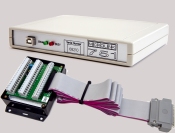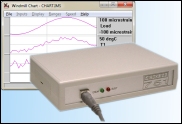The 751-TC package provides differential inputs to measure 16 thermocouple or voltage signals, an isothermal box, up to 32 digital inputs and outputs, 8 counters and Windmill data acquisition software for Windows. Connect 8 units to 1 PC to monitor 128 themocouples.
Features
- Monitor themocouples, or voltage signals, through 16 differential input channels
- Switch up to 32 digital outputs
- Monitor up to 32 digital inputs
- Count events with up to 8 counters
- Options to also monitor strain, pressure and current
- Includes the powerful yet easy-to-use Windmill Software for Windows: no programming required
- Connect up to 8 USB units to one PC, giving 128 themocouple or voltage inputs and 256 digital inputs and outputs
- Built-in linearisation for B-, E-, J-, K-, N-, R-, S- and T-type thermocouples
- Choice of four analogue input ranges, selected with Windmill software individually for each channel
- Alternatively, choose automatic ranging and let the software match the input signal as closely as possible
- Integrating analogue-to-digital converter reduces electrical noise
- Use Windmill to select the resolution of the A-D converter (from 12- to 18-bits): choose high throughput or high resolution
- Automatic recalibration
- Powered from the PC
- Low power consumption
- Connects over USB
- Comprehensive User Manual
- Free technical support for life
- Money-back guarantee
Themocouple Measurement
When monitoring thermocouples it is essential that the system knows the temperature of one of the thermocouple junctions. Housing this junction in the isothermal box keeps the temperature constant, and a cold junction sensor in the box tells the system the temperature. You connect the thermocouple wires to screw terminals in the isothermal box, and connect the terminals to the USB unit with a ribbon cable. The isothermal box will also detect broken thermocouple leads for you. If you need more information on monitoring thermocouples, we have a tutorial on computerised themocouple measurement on our Data Acquisition Intelligence site, or contact our Technical Support Team.
Digital Inputs and Outputs
The 751-TC provides 32 digital I/O lines, arranged in four groups of 8. Use Windmill to choose whether each group is an input or an output. You can read or set the state of each line individually. Alternatively, you can switch several channels at the same time. Digital outputs allow you, for example, to switch on warning lights or buzzers should results cross alarm thresholds.
Counters
The USB unit has eight 16-bit totalling counters. Each counter starts at zero and counts pulses to a maximum of 65535. You can reset a counter at any time from Windmill software. You can use the counters in two modes: accumulating count and resetting count. In accumulating count the counter keeps counting until you reset it. In resetting count the counter shows the number of pulses since the last reading.
You can set a scale and offset factor to the count from software. For example if the pulses came from a flow meter which produced one pulse for every 50 millilitres, a scale factor of 0.05 would give a reading in litres.
The counters are found on 8 of the digital input and output lines. You can use any of these you don't need for counting as normal digital inputs: the counts are always maintained even if you don't plan to use them.
Software
Windmill Software is included in the price. This modular suite offers data logging, charting, alarm indication, output control, process mimic generators, sequence control, programming tools and other applications.
.
More Information
If you need more information please contact us. You might also be interested in an article on temperature measurement, which compares different temperature sensors and is on our Data Acquisition Intelligence site.
Windmill 751-TC Unit Specifications
Dimensions (mm) 180 x 120 x 40
Maximum length of cable 5 m
Maximum distance from PC can be increased by
use of USB hubs
ANALOGUE INPUTS
Maximum safe input voltage:
Power supply on ±48 V
Power supply off ±33 V
Transient ±300 V
Amplifier:
Ranges (V) ±0.01, ±0.1, ±1, ±10
Common mode range ±13 V
Relative accuracy of ranges:
gain = 1000 ±0.1%
gain = 1, 10, 100 ±0.05%
Analogue to Digital Converter:
Maximum linearity error ±0.02%
Resolution Integration Time Samples/Second
12 bits 2.5 msec 80
13 bits 5 msec 64
14 bits 10 msec 48
15 bits 20 msec 32
16 bits 40 msec 16
18 bits 160 msec 6
DIGITAL INPUTS/OUTPUTS
Maximum # inputs 32
Maximum # outputs 32
(selected through Windmill in ports of 8 lines)
Power-up state all inputs
Compatibility TTL and 5 V CMOS, can be made
contact closure compatible
Range 0 to 5 V
Output capability 15 LSTLL loads
Maximum I/O speed 160 channels per second
COUNTERS
Maximum # counters 8
Resolution 16 bits
Compatibility TTL, 5 V CMOS, can be made
contact closure compatible
Input voltage range 0 to 5 V
Maximum count speed 160 counts per second





